


|

|
| Page 1 2 3 4 5 6 7 | ||
|
Last night, insulation saved my life. Well, to be perfectly truthful, it didn't actually safe my life, but it did keep those last two beers ice-cold, enhancing my enjoyment of Law and Order, Criminal Intent. Insulation is stuff that stops heat from moving. It can be almost any material: Foam rubber, crumpled up newspaper, egg cartons, wool, straw or popcorn. This summer, I decided to conduct an experiment to see what material would make the best insulation. The plan was to arrange seven test boxes, each with a different type of insulation, to observe which material could best protect a seven pound bag of ice.
|
||
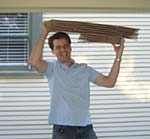
A trip to Office Circus yielded boxes, seven small and seven large. I hardly ever buy boxes, but these needed to be new, identical boxes so the experiment would be fair. |
||
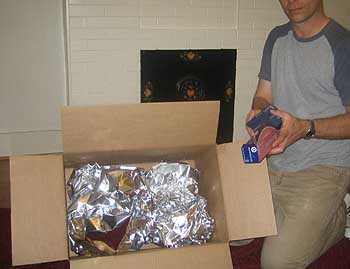
The first insulation I wanted to test was crumpled up aluminum foil. Aluminum foil is a good conductor for electricity, but I wasn't sure of how well it would conduct heat energy. In my test box it was crunched up, creating lots of little air-pockets. |
||

I really had a ton of ideas for insulating materials, including these air-filled packing pillows, but I needed to limit the number of materials I was testing in this experiment. The air-pillows did not end up being tested.
|
||
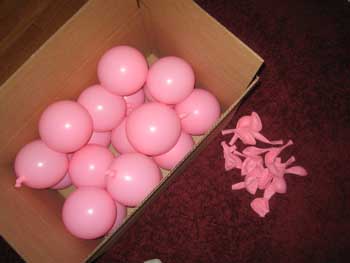
I opted instead for under-inflated party balloons. Rubber is known for being a good insulator, that's one of the reasons it is used for wetsuits and rubber chickens. I was very interested in how well these would work to insulate the ice, because I couldn't imagine heat traveling through them. |
||

The next insulation to be tested was rice crispy treats. This required six boxes of Rice Krispies and 10 bags of marshmallows. |
||

The recipe for Rice Krispy treats is surprisingly unforgiving. A few marshmallows off and you're looking at an ever-sticky snot blob or a fused block of sweet-crete. |
||

Stacy helped me prepare, cut and wrap the treats in plastic wrap. |
||
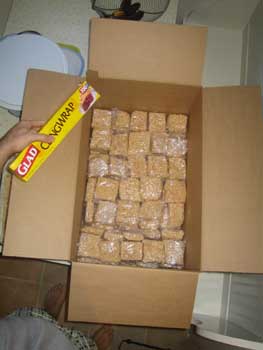
A two-treat thick layer lined the bottom of the box. I knew Rice Krispies would insulate well because they look a lot like styrofoam: Thousands of tiny air pockets glued together. |
||

The middle box protected from heat by a wall of Rice Krispies. Little known fact: Rice Krispies are used on the Space Shuttle heat shields. |
||

For the next insulation, I borrowed a few pounds of goose down feathers from Stacy's heirloom lockbox. When I was a kid, goose down feathers were the preferred insulation for winter coats and sleeping bags. Goose down has kind of a creepy vibe to it, like fur coats, or Mohair sweaters.
|
||

The insulating boxes were beginning to take shape. I was really excited about this experiment. I had been planning this one for ages. Shown here are the party balloons, aluminum foil and cardboard insulations.
|
||

The weather was cooperating too. The weather forecast was for temperatures in the 100 degree F (38C) range all weekend. The middle box here is testing the insulative power of used baby diapers. Don't panic, these are only "code one" dirty diapers, and baby pee isn't gross, it is cute. On the left is an industrial favorite: Chunks of styrofoam. A few friends believed that the styrofoam would perform best. |
||
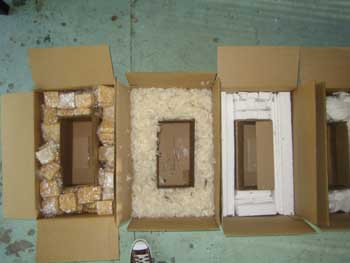
And rounding out the seven are the Rice Krispie treats and goose down feathers. |
||
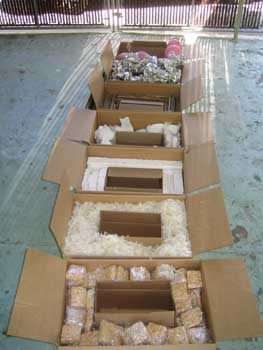
Insulation is one of those things that struck me immediately, like fluorescent light bulbs or backyard clothesline, as a cost-effective way to conserve energy and save money. Insulation protects your climate investment, and even if you choose an expensive insulative material, it is very likely to pay off with lower energy bills. Please continue reading page 2 of the insulation experiment. |
||
| Page 1 2 3 4 5 6 7 |
Home | Contact Rob | How Much is Inside | Pranks | Incredible Stuff | Science Club
Dec 18, 2005